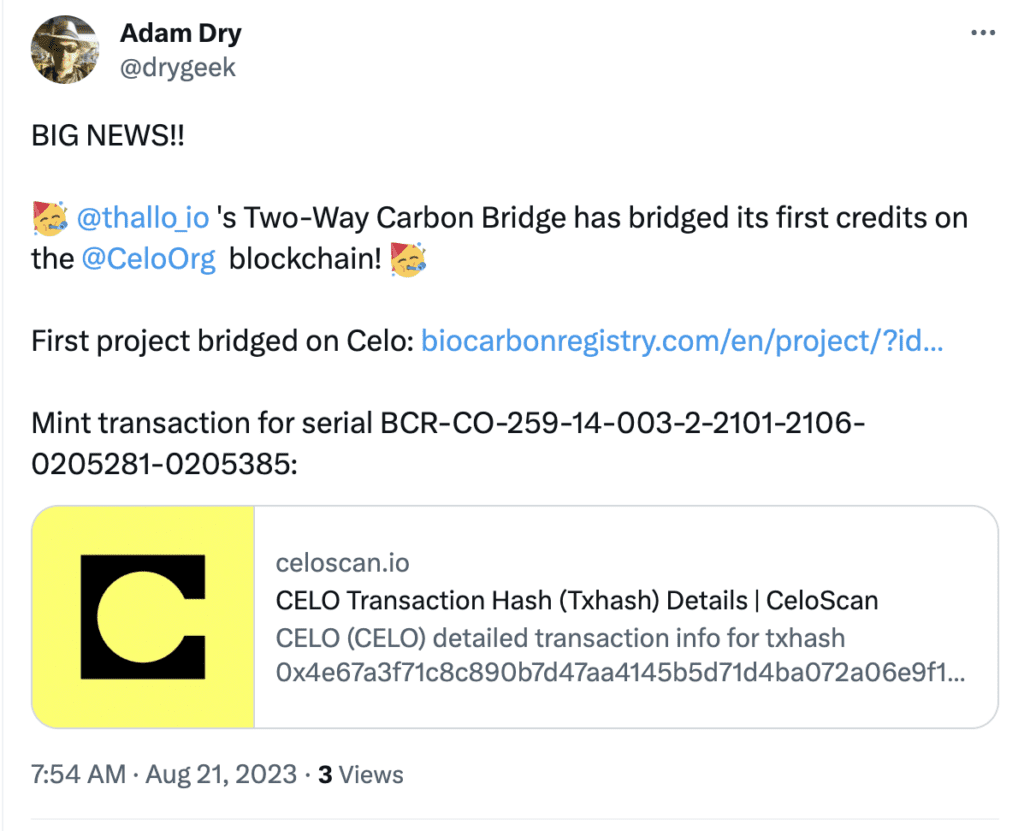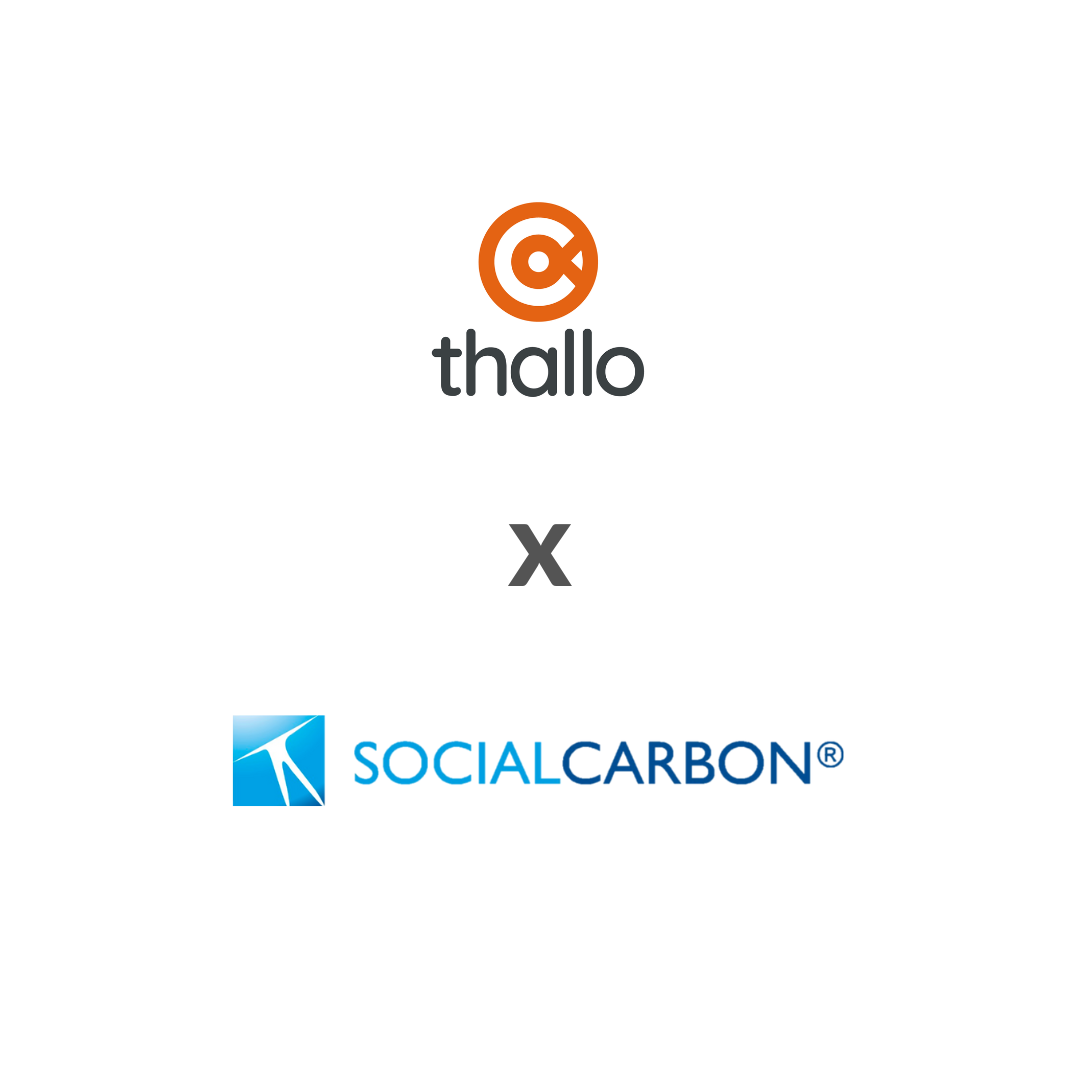Today, we’re excited to share some big news: Thallo has deployed its first carbon credits onto the Celo blockchain via its two-way carbon bridge!
It’s no secret that the Celo ecosystem and the Climate Collective have been an innovation ground for ReFi, or regenerative finance, projects. (For those new to the term, “ReFi” generally refers to projects that use blockchain technology and web3 tools to solve environmental or social challenges – essentially: blockchain for good. Read more here.)
Together, Celo and Climate Collective have been leading the way for impact-oriented projects, with an incredible community of builders; a great grantmaking arm (which Thallo has been a recipient of); and some of the most exciting and inclusive events in the space.
So it’s a natural fit that climate tech company Thallo would deploy to the network, bringing carbon credits onto the Celo layer 1 blockchain through Thallo’s two-way bridge.
First, what is a Two-Way Bridge?
Thallo made headlines with its two-way carbon bridge last year. But what is it?
A two-way carbon bridge might sound like a complex term, but it’s simply a piece of technological infrastructure that allows carbon credits to be brought securely from a registry onto the blockchain.
The “two-way” refers to the fact that the carbon credit representation on the blockchain remains linked to the underlying credit on the registry. This means that retirement is performed both on-chain and on the underlying registry at the same time. This innovative approach ensures a seamless and integrated management of carbon credits, enhancing their usability and traceability. The credits can also be brought back off of the blockchain if desired.

Here’s how it works:
- Bringing Credits On-chain: The carbon credit on the blockchain remains linked to its underlying registry. This connection ensures that any trade or retirement of the credit is reflected in both places simultaneously, avoiding any double counting.
- Tokenizing Carbon Credits: Sometimes, you’ll hear this process referred to as “tokenizing.” It’s the creation of a blockchain-based version of the carbon credit, known as a “tokenized carbon credit” or sometimes as a “digital carbon credit.”
Read more about Thallo’s two-way carbon bridge here.
How Did Thallo Do It?
From the inception of Thallo’s two-way bridge design we decided on a “hub and spoke” model to ensure we remain blockchain agnostic and are able to incorporate the best, greenest blockchain technology available. Celo has the wellbeing of the environment at its core and so it was an obvious and natural fit for Thallo.
Thallo has developed an adapter pattern allowing us to plug into different blockchains while still being able to re-use the majority of our core management infrastructure. This gives us the opportunity to integrate with new technologies at speed, whilst still taking advantage of all the advanced security and data integrity mechanisms we have developed.
You can head over to our CTO Adam Dry’s Twitter account for more:

Why Does This Matter?
Though the world of carbon and blockchain technology is nascent, each milestone is important. This one in particular is a step forward in interoperability, since Thallo has previously deployed to Polygon and expects to deploy to XRPL soon (read more on the strategy here).
Furthermore, bringing carbon credits onto the blockchain is an innovative approach that:
- Increases Accessibility: By having more credits on-chain, a broader spectrum of individuals and organizations can access and trade carbon credits more effortlessly.
- More climate financing: Increased access to carbon credits for new and diverse communities means more opportunities for individuals and businesses to take climate action, and increased demand ultimately means more financing going towards worthy projects on the ground.
- Fairer economic systems: Thallo’s royalties feature ensures that if a carbon credit isn’t retired, but instead is traded to someone else, a portion of that secondary trade revenue goes back to the original project developer. This increases fairness and equity in the system.
- Enhances Transparency: The blockchain’s transparent and immutable nature ensures that every transaction and action related to the carbon credit is recorded and verifiable, adding a new layer of trust to a traditionally very opaque and fragmented system.the system.
- Empowers Communities: Though not directly part of Thallo’s bridge, the traceability of blockchain will likely one day mean that disbursement of funds can be traced all the way back to the community level, to ensure that communities are being fairly compensated. On the project origination side, decentralized data collection could be a new source of employment and economic empowerment for communities. This promotes sustainability and social empowerment at the grassroots level.
Conclusion
Thallo’s successful bridging of carbon credits to Celo opens a new chapter in the dynamic world of blockchain and climate tech. By leveraging this technology, Thallo is not only redefining how we understand and use carbon credits but also building bridges (technological and figurative!) towards a more sustainable and accessible future. It’s more than just a technological achievement; it’s a symbol of the future of climate action.
📣 Join the Conversation on Telegram!
Are you passionate about climate tech and eager to stay at the forefront of innovation? We invite you to join our community on Telegram, where you can engage with our team, ask questions, and share your thoughts on our latest advancements.
Our Telegram channel is more than just a news source; it’s a space for collaboration, learning, and inspiration. Connect with like-minded individuals and be a part of the change towards a more sustainable and equitable future.
🔗 Click here to join Thallo on Telegram and become part of our vibrant community. Together, we are shaping the future of climate action!







